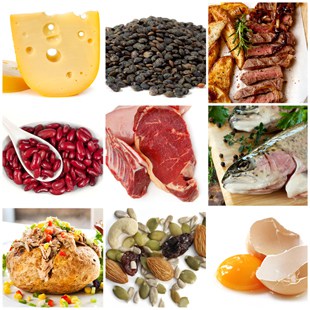How Our Diet May Help Prevent Osteoporosis
There are a number of components or micronutrients such as calcium, vitamin D and zinc that promote bone health and reduce the risk of bone loss and osteoporosis.
Calcium
Around 99% of the body’s calcium is stored in bones and teeth. Calcium plays a vital role in bone formation (the laying down of new bone) and bone resorption, the process by which old bone is re-absorbed by the body.
Foods such as milk, yogurt and cheese are the main sources of calcium – an 8 oz. glass of milk contains around 300 mg of calcium. This important mineral is also found in some meats and canned fish such as sardines, greens, almonds or other foods (in the form of supplementation) such as soy yogurts and cereals. In the US, the recommended daily calcium intake is 1200 mg and in Australia and New Zealand, 1300 mg. For those who cannot obtain enough calcium from their daily diet, then supplements may help. Some trials report a supplement dose of 1,050 mg per day is able to improve bone mass and reduce fracture risk.
Vitamin D
The main source of vitamin D is form exposure to the UV-B rays from the sun, although vitamin D is also available in foods such as fatty fish (salmon, tuna and mackerel), egg yolks, cheese and beef liver. A number of products such as breakfast cereals are also supplemented with vitamin D. Some researchers suggest that higher doses of vitamin D may help to prevent osteoporosis, while some say that vitamin D offers effects that are modest at best. However, researchers do know that vitamin D plays an important role in promoting the absorption of calcium in the body and also helps maintain the correct amount of calcium in blood serum.
Around 50% of adults may be deficient in vitamin D, which causes the calcium otherwise stored in the bones to be released into the body. The current recommended daily intake for Australia and New Zealand is 5 micrograms per day for those under 50, increasing to 10, in those 50 or older. Spending 10 minutes a day in the sun is often enough time for the body to produce the vitamin D that it requires, however supplements are also available for those who may struggle obtaining enough vitamin D.
Vitamin K
Eating a fiber-rich diet encourages bacteria in the gut to produce vitamin K2. This has a number of roles including increasing bone mineral density (BMD) and reducing fracture risk. Vitamin K2 is also available from dairy products and meats and vitamin K1 (which is essential for blood clotting) is in leafy vegetables, avocado, grapes and kiwi fruits. Vitamin K may also support the work of vitamin D in the body.
Magnesium
Dietary sources of magnesium include wholegrains such as wheat bran, nuts, spinach and beans. Estimates suggest around two thirds of adults do not have their daily magnesium intake, contributing to weakness and lethargy. Approximately 50% of the body’s total magnesium is in bone and lower magnesium intakes are associated with higher levels of bone loss in animals and humans.
Zinc
The body is unable to store zinc, which means that it must be obtained from sources such as meat, seafood, legumes and wholegrains. Many foods such as breakfast cereals are also fortified with zinc. Zinc deficiency delays bone growth during the bone cycle and zinc is also important to maintain other musculoskeletal structures such as ligaments, tendons and muscle.
References
- Bonnick, S.L. (2000). The osteoporosis handbook: the comprehensive guide to prevention and treatment. Institute for Women’s Health, Texas Woman’s University. New York: Cooper Square Press.
- Colbin, A. (2009). The Whole-Food Guide to Strong Bones: A Holistic Approach. Oakland, CA: New Harbingers Publications, Inc.
- Cosman, F. (2003). What Your Doctor May Not Tell You about Osteoporosis. New York: Warner Books, Inc.
- Gates, R. & Whipple, B. (2000). Smart Women: Strong Bones. Lake Oswego, OR: LIFESTYLES Four Heart Press.
- U.S. Department of Health and Human Services. Bone Health and Osteoporosis: A Report of the Surgeon General. Rockville, MD: U.S. Department of Health and Human Services, Office of the Surgeon General, 2004.
- Robert K. Rude, Helen E. Gruber, H. James Norton, Livia Y. Wei, Angelica Frausto, and Barbara G. Mills (2004). Bone Loss Induced by Dietary Magnesium Reduction to 10% of the Nutrient Requirement in Rats Is Associated with Increased Release of Substance P and Tumor Necrosis Factor-α. J Nutr. vol. 134 no. 1. 79-85. Available here: http://jn.nutrition.org/content/134/1/79.long
- http://ods.od.nih.gov/factsheets/Calcium-HealthProfessional/
- http://ods.od.nih.gov/factsheets/VitaminD-HealthProfessional/
- http://www.ars.usda.gov/is/ar/archive/mar98/zinc0398.pdf
- http://ods.od.nih.gov/factsheets/Magnesium-HealthProfessional/
Last Reviewed 13/Mar/2014
